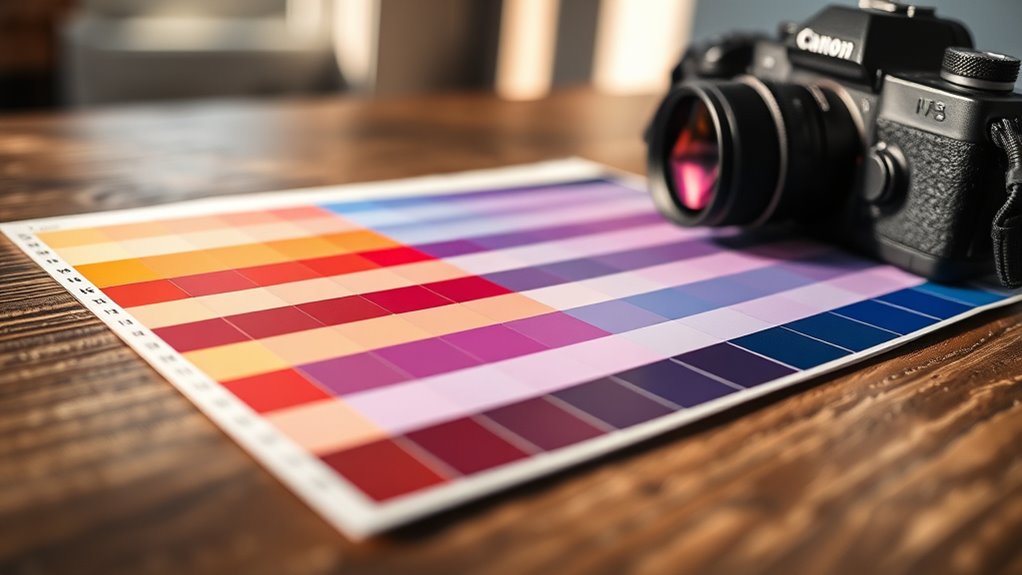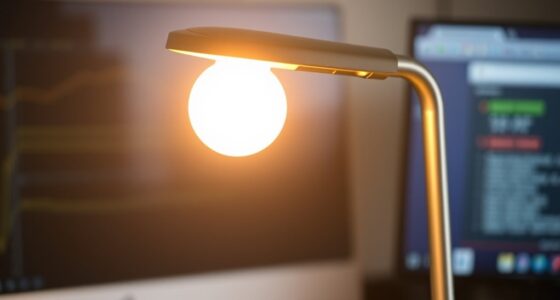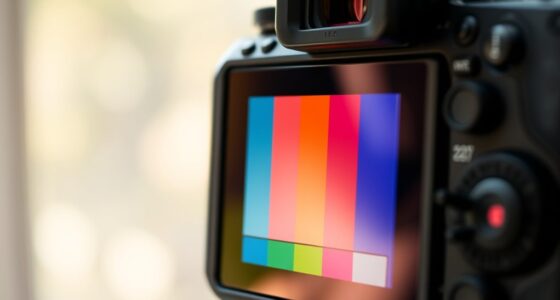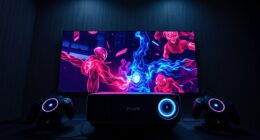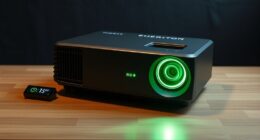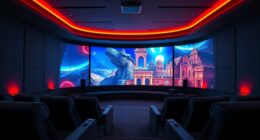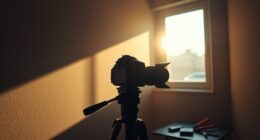To keep your color accurate, use reliable calibration devices compatible with your work setup and document environmental details like lighting conditions and time. Recognize that standard tools have limitations and may not account for ambient lighting or spectral sensitivities. Create consistent workflows with portable references and update profiles regularly. By adjusting monitor settings properly and maintaining consistent lighting, you can achieve dependable color accuracy. Keep exploring these practical strategies to ensure your colors stay true across all environments.
Key Takeaways
- Standard calibration tools may not account for spectral sensitivities; supplement with standardized test images and ambient lighting control.
- Document environmental details such as lighting conditions, time, and filters used to ensure consistent, reliable field notes.
- Use portable calibration software and reference color charts for quick on-the-go adjustments aligned with current lighting.
- Regularly verify calibration accuracy by comparing neutral tones and neutral test images to detect drifts or shifts.
- Incorporate calibration routines into your workflow, noting device settings, environmental factors, and adjustments for ongoing color fidelity.
Understanding the Limitations of Standard Calibration Tools
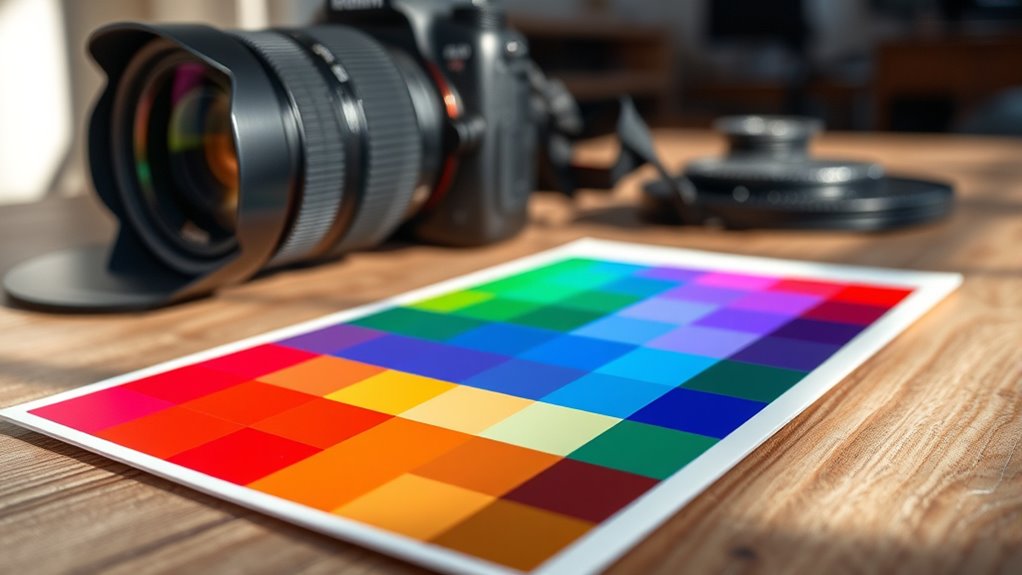
While standard calibration tools are widely used, they often fall short of delivering perfect color accuracy. One key limitation is their inability to account for spectral sensitivity differences across displays and viewing environments. These tools typically assume a fixed response, ignoring how ambient lighting influences perceived colors. If your workspace has variable lighting conditions, calibration results can become inconsistent, leading to color shifts or inaccuracies. Additionally, many tools don’t adapt to the nuances of spectral sensitivity, which varies between screens and human vision. As a result, even properly calibrated devices may not reflect true colors under different lighting scenarios. Recognizing these limitations helps you understand why standard calibration methods may not always achieve the precision you need, especially in professional workflows demanding high fidelity. spectral sensitivity can significantly impact perceived color accuracy and should be considered in advanced calibration processes.
Choosing the Right Calibration Devices for Your Workflow
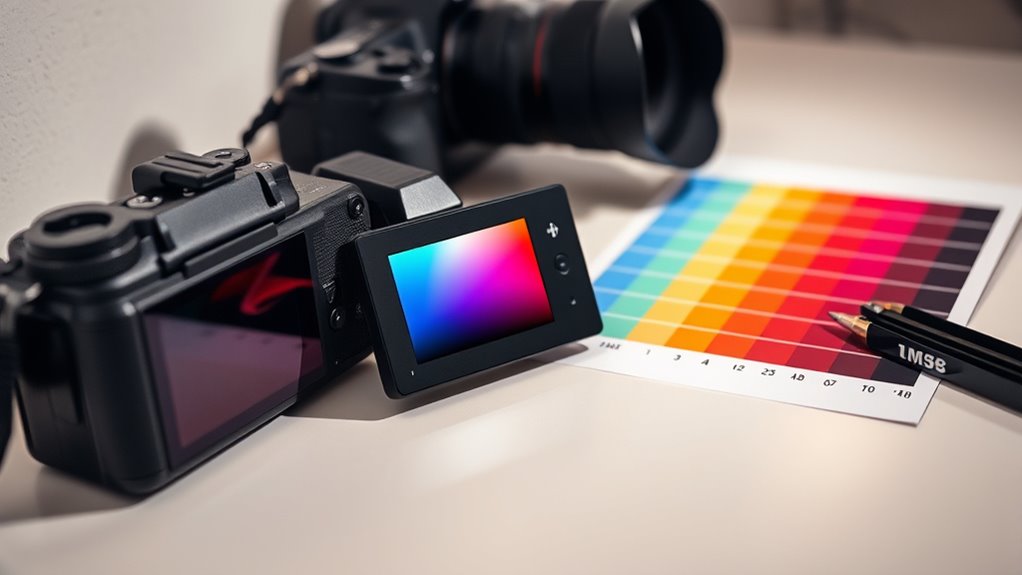
When selecting calibration devices, you need to make certain they’re compatible with your existing equipment to avoid issues later on. Consider how often you’ll need to calibrate—more frequent calibration might justify investing in advanced features. Balance your budget with the device’s capabilities to get the best value for your workflow. Additionally, understanding the importance of proper calibration can help ensure color accuracy and consistency in your work.
Device Compatibility Checks
Selecting the right calibration device is crucial to ensuring accurate color reproduction in your workflow. To do this, you need to verify device interoperability and software compatibility. Imagine connecting a colorimeter seamlessly to your monitor, with no glitches or driver conflicts. Picture the calibration software recognizing your device instantly, syncing effortlessly with your editing tools. Check that your device supports your operating system and integrates smoothly with your preferred color management software. Consider whether the device communicates via USB, Ethernet, or wireless, and if it’s compatible with your current hardware setup. Ensuring these aspects prevents calibration errors and saves time troubleshooting. Color accuracy is fundamental for achieving consistent visual results across different devices and platforms. A well-matched device enhances efficiency, giving you confidence that your colors are consistent across all platforms and tools.
Calibration Frequency Tips
Choosing how often to calibrate your devices depends on your workflow and how frequently your displays or printers change over time. Regular calibration is essential to counteract sensor drift, which can cause color inaccuracies. If you work in environments with fluctuating ambient conditions, like varying light or temperature, you’ll need more frequent calibrations to maintain consistency. For daily use or critical color tasks, calibrate at least once a week or before major projects. Less frequently used devices may only require monthly calibration. Keep an eye on how your equipment responds over time, and adjust your schedule accordingly. The goal is to catch sensor drift early and ensure your devices remain reliable, regardless of external factors. Additionally, understanding color accuracy standards can help determine the appropriate calibration frequency for your specific needs.
Budget vs. Features
Balancing your budget with the features you need is essential for selecting the right calibration device. Cost considerations play a significant role, but don’t overlook the importance of brand comparisons to ensure quality and reliability. Cheaper models might save money upfront but could lack advanced features or accuracy, leading to costly mistakes later. Think about the specific demands of your workflow:
- Precise color matching for print production
- Ease of use for quick adjustments
- Compatibility with your hardware and software
- Long-term durability and support
Investing in reputable brands can often provide more consistent color accuracy and better calibration results over time. Imagine a device that fits comfortably in your hand, displays subtle color differences, and adapts to your environment—all within your budget. Prioritize features that align with your workflow to make a confident, cost-effective choice.
Creating Reliable Field Notes for Color Consistency
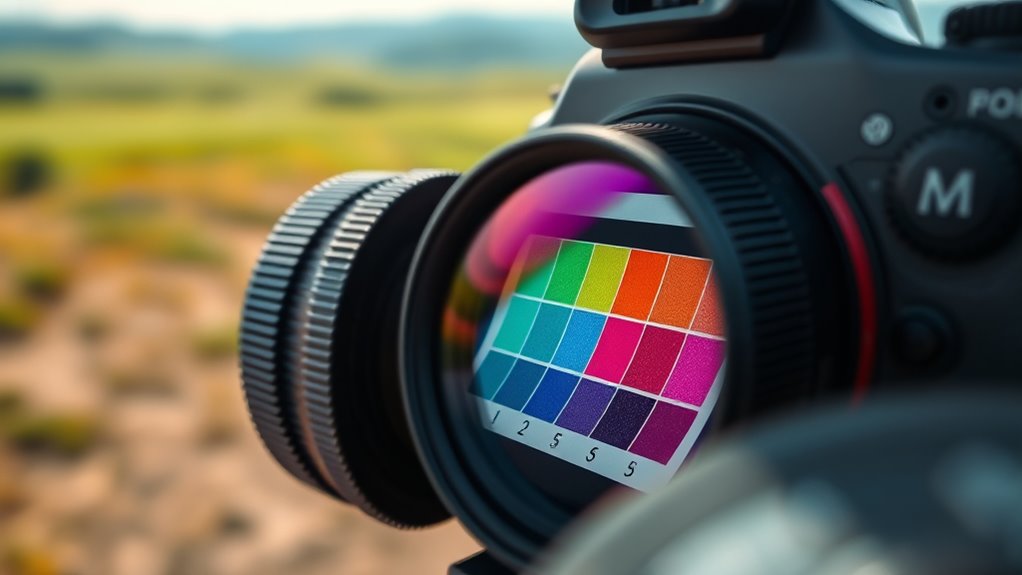
To guarantee your field notes accurately reflect true colors, establishing a consistent and reliable recording process is essential. Your perception of color can vary based on lighting and context, so focus on standardizing how you record it. Use neutral lighting conditions whenever possible, and avoid relying solely on your memory or assumptions. Be aware of Calibration myths—believing your eyes are enough for color accuracy can lead to errors. Instead, develop a systematic approach, such as using reference color charts or standardized notes that include environmental details. Consistency is key; document the lighting, time of day, and any filters used. Proper color calibration techniques can significantly improve the accuracy of your observations. With disciplined habits, you’ll improve the reliability of your color documentation and minimize subjective discrepancies.
Practical Techniques for On-the-Go Color Calibration
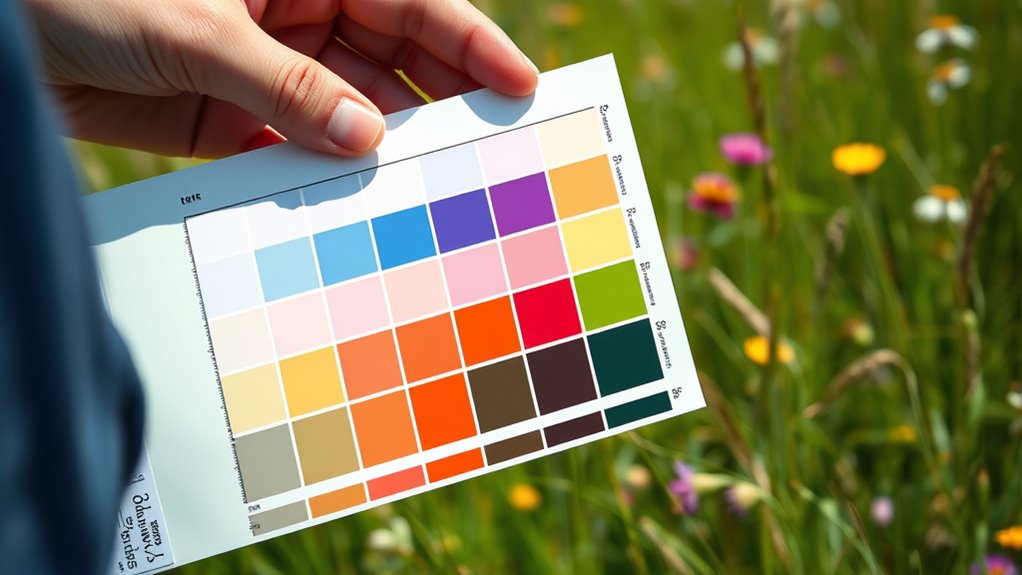
When you’re out in the field, maintaining color accuracy requires practical, easy-to-implement calibration techniques that work without specialized equipment. Start by adjusting your device’s color profiles using calibration software designed for on-the-go use. Keep a portable gray card or color reference chart handy to compare and tweak colors directly on your device. Use calibration software to create custom profiles that suit your current lighting conditions, ensuring consistent results. Regularly update your profiles as lighting changes to prevent color drift. Focus on simple, repeatable steps to verify your calibration, such as comparing your display against known neutral tones. These techniques help you stay confident in your color accuracy without bulky tools or complex setups. Additionally, being aware of vetted products for safety and effectiveness ensures you’re using reliable calibration tools and materials in the field.
Troubleshooting Common Color Accuracy Issues

When your colors seem off, start by checking for any color shifts that might be affecting your display. Then, adjust your monitor settings to correct these issues, and make sure your lighting conditions are consistent. These simple steps can often resolve common color accuracy problems quickly and effectively. Additionally, calibrating your monitor with proper calibration tools can ensure your colors remain accurate over time.
Identifying Color Shifts
Color shifts can often be subtle yet impactful, making them tricky to spot without a keen eye. You might notice perceptual differences when viewing the same image on different screens or under varying lighting. Look for subtle cues like a blue tint creeping into shadows or reds appearing dull or washed out. These are signs of color shifting that can distort your work’s accuracy. To identify these shifts, examine your images side by side, especially in neutral areas like grays or whites. Pay attention to inconsistencies in skin tones or natural objects. Keep in mind, perceptual differences can be deceptive, so use standardized viewing conditions and test images to confirm real color shifts. Recognizing these subtle cues helps you correct issues early and maintain true color fidelity. Additionally, understanding how calibration affects color accuracy can help prevent these issues from occurring in the first place.
Adjusting Monitor Settings
Adjusting your monitor settings is a crucial step in troubleshooting common color accuracy issues. Your display technology influences how colors are rendered, so fine-tuning your monitor helps align what you see with true color perception. Start by adjusting brightness and contrast to ensure details aren’t lost or washed out. Then, calibrate the color temperature—usually around 6500K—to match daylight conditions for accurate color rendering. Use your monitor’s built-in settings or calibration tools to tweak gamma and individual color channels. Keep in mind that different display technologies, like LCD or OLED, may respond differently, so test adjustments across various images. Making these adjustments helps guarantee your monitor accurately reflects colors, improving your workflow and reducing color shifts caused by incorrect settings. Proper calibration is especially important for professionals working in color-sensitive fields, ensuring consistent and reliable color output.
Ensuring Proper Lighting
Proper lighting plays a essential role in maintaining color accuracy, especially after you’ve fine-tuned your monitor settings. Without proper ambient lighting, colors can appear distorted or inconsistent. To guarantee ideal viewing conditions, pay attention to your environment’s lighting conditions. Adjust the color temperature of your ambient lighting to match your workspace, ideally around 5000K to 6500K, for a neutral tone. Avoid overly warm or cool lighting that skews color perception.
Imagine:
- Soft, neutral light that minimizes glare and reflections
- Consistent ambient lighting that doesn’t fluctuate throughout the day
- Avoiding direct sunlight or harsh fluorescent lights
- Using adjustable lamps to fine-tune your workspace’s lighting conditions
Incorporating Calibration Into Your Post-Processing Routine
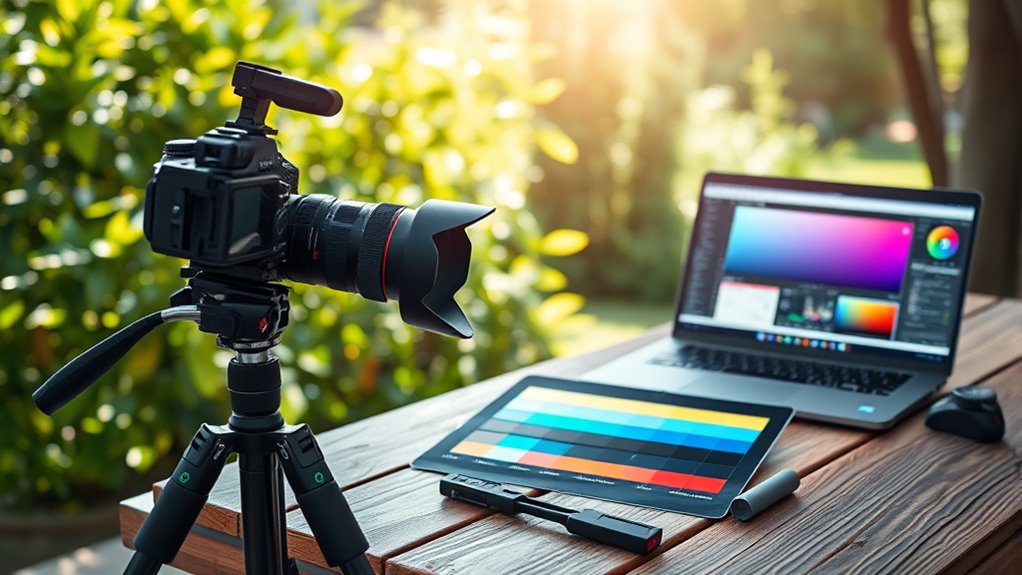
To guarantee your images maintain consistent and accurate colors, incorporating calibration into your post-processing routine is essential. Start by creating accurate color profiles for your monitor using software calibration tools. This ensures your display reflects true colors before editing. Once calibrated, save and apply these profiles consistently across your workflow. When editing, regularly check your monitor’s calibration to avoid drift over time. Incorporate color profiling into your editing software, which allows you to visualize how your images will appear on different devices or prints. By maintaining a disciplined calibration routine, you’ll reduce guesswork, achieve more predictable results, and ensure your final images stay true to your original vision. Proper calibration and color profiling are key to professional, reliable color accuracy.
Frequently Asked Questions
How Often Should I Recalibrate My Devices for Optimal Color Accuracy?
You should recalibrate your devices every 4 to 6 weeks to maintain ideal color accuracy. Regular calibration helps extend device longevity by preventing color drift over time. If you notice color inconsistencies or your environment changes markedly, increase calibration frequency. Consistent calibration ensures your screens display true colors, saving you time and frustration, and keeping your work accurate and professional.
Can Ambient Lighting Conditions Affect Calibration Results in the Field?
Lighting variability considerably impacts calibration accuracy, so you should consider environmental stability when working in the field. Fluctuating ambient lighting can distort color perception, forcing you to recalibrate more frequently. To maintain consistency, try to stabilize lighting conditions—use shaded areas or portable light sources—and perform calibrations under similar lighting environments. This approach minimizes discrepancies, ensuring your colors stay true regardless of changing surroundings.
What Are the Best Practices for Documenting Calibration Procedures?
You should keep detailed calibration documentation by recording each step of your procedure, including equipment used, settings, and environmental conditions. Use standardized procedures to guarantee consistency across different sessions and devices. Always date and sign your records, and include any adjustments made. This practice of procedure standardization helps maintain color accuracy, simplifies troubleshooting, and provides clear evidence of calibration efforts, making future calibrations more efficient and reliable.
How Do I Ensure Consistent Color Accuracy Across Multiple Devices?
Keeping your devices in sync is like tuning a finely crafted instrument. To guarantee consistent color accuracy, you should regularly monitor ambient lighting, as it impacts how colors appear. Choose reliable calibration software tailored for your devices, then perform calibration sessions consistently. Document each step, and compare results across devices to spot discrepancies early. This approach keeps your color workflow harmonious and accurate, no matter how many devices you manage.
Are There Specific Color Targets Recommended for Field Use?
You should choose color targets designed for field use, like the X-Rite ColorChecker Passport, which offers reliable color target selection and portability. For field calibration tips, guarantee you shoot under consistent lighting conditions and calibrate your devices regularly with these targets. This approach helps maintain accurate color reproduction across multiple devices, making your workflow more consistent and trustworthy in diverse environments.
Conclusion
Just like seasoned explorers rely on true north, your workflow needs reliable calibration. Don’t let elusive color shifts steer your work off course—embrace practical tools and techniques that keep your colors true, no matter where you are. By integrating these habits into your routine, you’ll navigate the complex landscape of color accuracy with confidence, ensuring your images tell the story just as vividly as you envisioned, guided by the steady compass of proven calibration methods.
